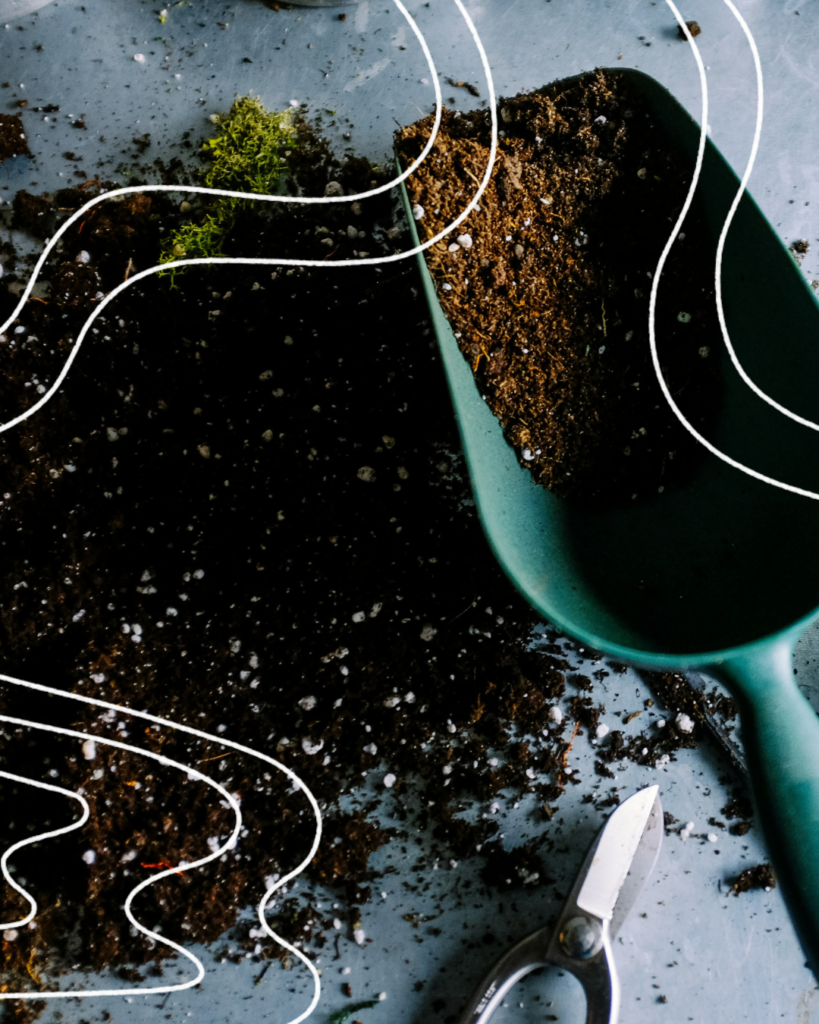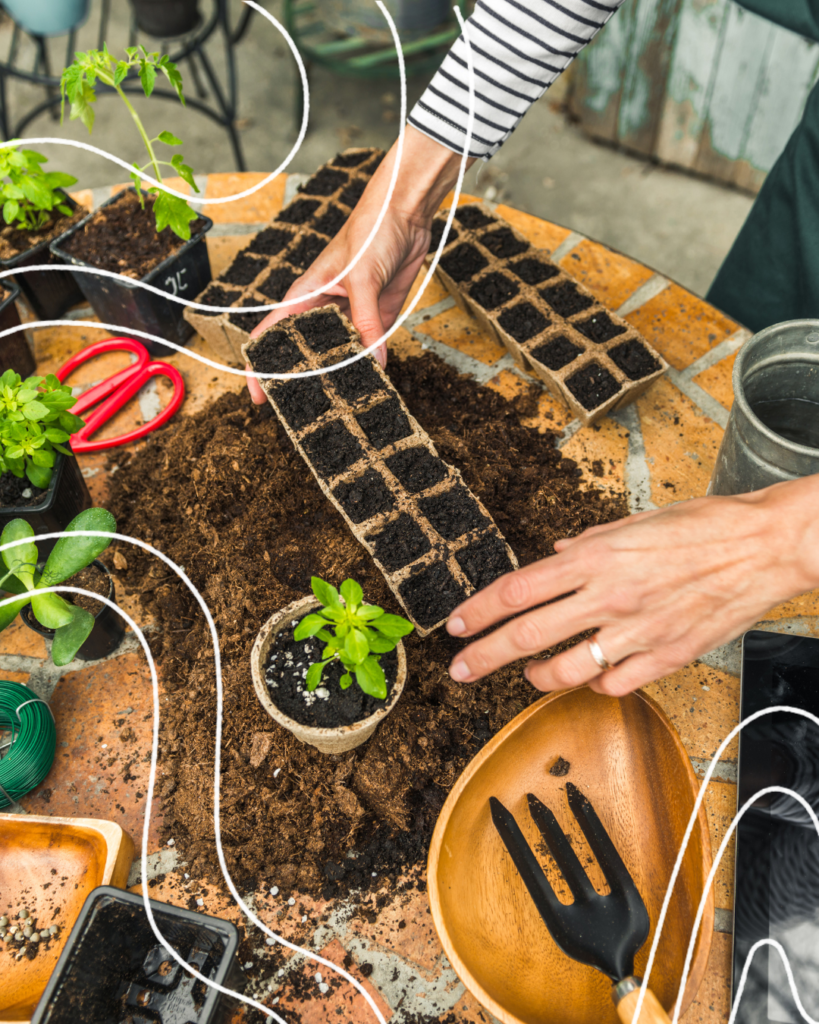Spring in Quebec: start planting and planning your garden

Planting seedlings at home, then spending all summer harvesting basket upon basket of fruits and veggies – that’s the dream, right? Well, dream no more. It’s actually super attainable as long as you choose the right seeds and follow a few important steps.

In this article, we’ll explain how to choose the right varieties, when to start them, and how to get your garden off the ground.
What do you need to start your seeds?
Step one: gather your materials! You won’t need to spend much on your seed-starting setup. In fact, you can even repurpose everyday items for some of the necessary equipment.
- Containers: Use biodegradable pots or seedling trays for an easy start. You can also reuse containers you have around the house as long as you punch drainage holes through the bottom. Make sure your containers can retain moisture until the seeds have germinated.
- Quality potting soil for seedlings: Choose a light and aerated type of soil specifically for seedlings to make sure they germinate properly.
- Lighting (optional): If your space lacks natural light, consider using LED lamps or fluorescent tubes to provide the necessary light.
- Heat source (optional) : A heat mat can be useful for certain seedlings to germinate faster, including tomatoes and peppers.
- Labels: Write the name of the plant and the date you planted the seeds on a label to avoid confusion down the line.
- Spray bottle: For gentle watering that won’t disturb your seeds or young sprouts.

Choose the right plants at the right time
Our long winters and short summers are uniquely challenging for gardeners. Choosing cold-hardy or fast-growing varieties can help you achieve a prolific garden under these conditions.
In addition to selecting the right seeds, starting your seedlings at the right time (not too early, not too late) is a must for a successful transition to the outdoors, minimizing the risk of frost and transplant stress. Starting too early can result in weak and bulky plants, and starting too late can reduce growing time, which will affect yield. If you time all of this precisely, you’ll be able to couple plant development with ideal outdoor conditions, ensuring healthy growth and a great gardening season.
For reference, in Quebec, the last frost typically occurs between April 29 and June 19 depending on the region.
Fruits
- Ground cherries: Sow indoors 6-8 weeks before the last frost. Full sun, well-draining soil. Transplant outdoors once there is absolutely no risk of frost.
- Melon: Sow indoors 4-6 weeks before the last frost. Full sun, well-draining soil. Early varieties recommended. Water regularly. Transplant outdoors once there is absolutely no risk of frost.

Flowers
- Nasturtiums: Direct seeding after the last frost. Full sun to partial shade, poor to moderate soil. Edible flowers and leaves.
- Cosmos : Direct seeding after the last frost. Full sun, well-draining soil. Easy to grow, attracts pollinators.
- Lavender : Sow indoors 8-10 weeks before the last frost. Full sun, well-draining soil. Look for hardy varieties.
- Lupins: Direct seeding in fall or spring. Full sun to partial shade, slightly acidic soil. Cold-hardy with a wide range of colors.
- Daisies: Direct seeding in fall or spring. Full sun, well-draining soil. Perennial flowers, very hardy.
- Petunias: Sow indoors 10-12 weeks before the last frost. Full sun to partial shade, light soil. Colourful flowers all summer long.
- Marigolds: Direct seeding after the last frost. Full sun, well-draining soil. Repels certain pests, easy to grow.
- Sunflowers: Direct seeding after the last frost. Full sun, well-draining soil. Adds height and colour, perfect for summer.
- Zinnias: Direct seeding after the last frost. Full sun, well-draining soil. Flowers continuously until the first frost.
Vegetables
- Eggplant: Sow indoors 8-10 weeks before last frost. Full sun, well-draining soil. Requires a warm summer or greenhouse.
- Carrots: Direct seeding 2-3 weeks before last frost. Full sun, moist soil. Cold-resistant varieties are a good choice.
- Cauliflower: Sow indoors 4-6 weeks before last frost. Full sun, rich and moist soil. Highly resistant to cold.
- Brussels sprouts: Sow indoors 4-6 weeks before last frost. Full sun, rich and well-draining soil. Requires a long growing season.
- Cucumbers: Direct seeding 3-4 weeks before the last frost or directly into the soil afterwards. Full sun and constantly moist soil. Thrives in a greenhouse.
- Shallots: Direct seeding at the beginning of spring once the soil can be worked. Full sun, rich and well-draining soil. Excellent for cooler climates.
- Peppers: Direct seeding after last frost. Full sun, moderate watering. Select varieties that mature quickly.
- Lettuce and spinach: Seed directly once the soil can be worked. Prefer partial shade and well-draining soil, perfect for spring and fall.
- Corn: Direct sowing after last frost when soil is sufficiently warm. Full sun, rich and well-watered soil. Choose early varieties.
- Onion: Sow indoors 8-10 weeks before last frost or plant right at the beginning of spring. Full sun, rich and well-watered soil. Suitable for cool climates.
- Peas: Seed directly once soil can be worked. Full sun to partial shade, moist soil. Excellent for the beginning of the season.
- Radish: Seed directly once soil can be worked. Full sun to partial shade, soil kept moist. Fast-growing, ideal for ongoing harvesting.
- Tomato: Sow indoors 6-8 weeks before last frost. Prefer full sun and require regular watering. Early-maturing varieties recommended.
- Squash and pumpkin: Direct seeding once there is absolutely no risk of frost. Full sun, regular watering. Ideal for end-of-season harvesting.
How to sow your seeds step by step
- Soaking: some seeds, like legumes, need to be soaked before they are planted to accelerate germination. Check your seed packaging for details.
- Preparation: Use a potting soil formulated specifically for seedlings and make sure your containers are clean to avoid disease.
- Seeding: Sow at the depth recommended on the seed packet, which is generally two to three times the diameter of the seed.
- Initial care: Keep the soil moist but not soggy and place your seeds in a well-lit area.
- Patience: Some plants may take a few weeks before they germinate! Let nature take its course.
- Preparing the garden: Make sure you have quality gardening soil that’s enriched with compost and a deep enough area to accommodate your plants.
- Acclimatizing seedlings: Your seedlings may be sensitive to thermal shock when placed in direct sunlight. For about a week before you plant them outside, gradually expose them to outdoor conditions by taking them outside for a few hours every day.
- Watering the soil: Before you start planting, dig your holes with adequate space between them and make sure the soil is moist. This will help young plants adapt.
- Protection: If you plant early on in the spring, use frost protection (like tunnels).

And there you have it! You have everything you need to successfully grow and transplant seedlings. Happy gardening!
Read also
Following your true nature: daring to go against the grain with Amelia Hadouchi
The circular economy: definition and impact
Following your true nature: Ode to the beige life with Emilie Seguin
Comments are closed.
- Published on , in
- Blog
- The Recycle of Life
share
Read also
See all